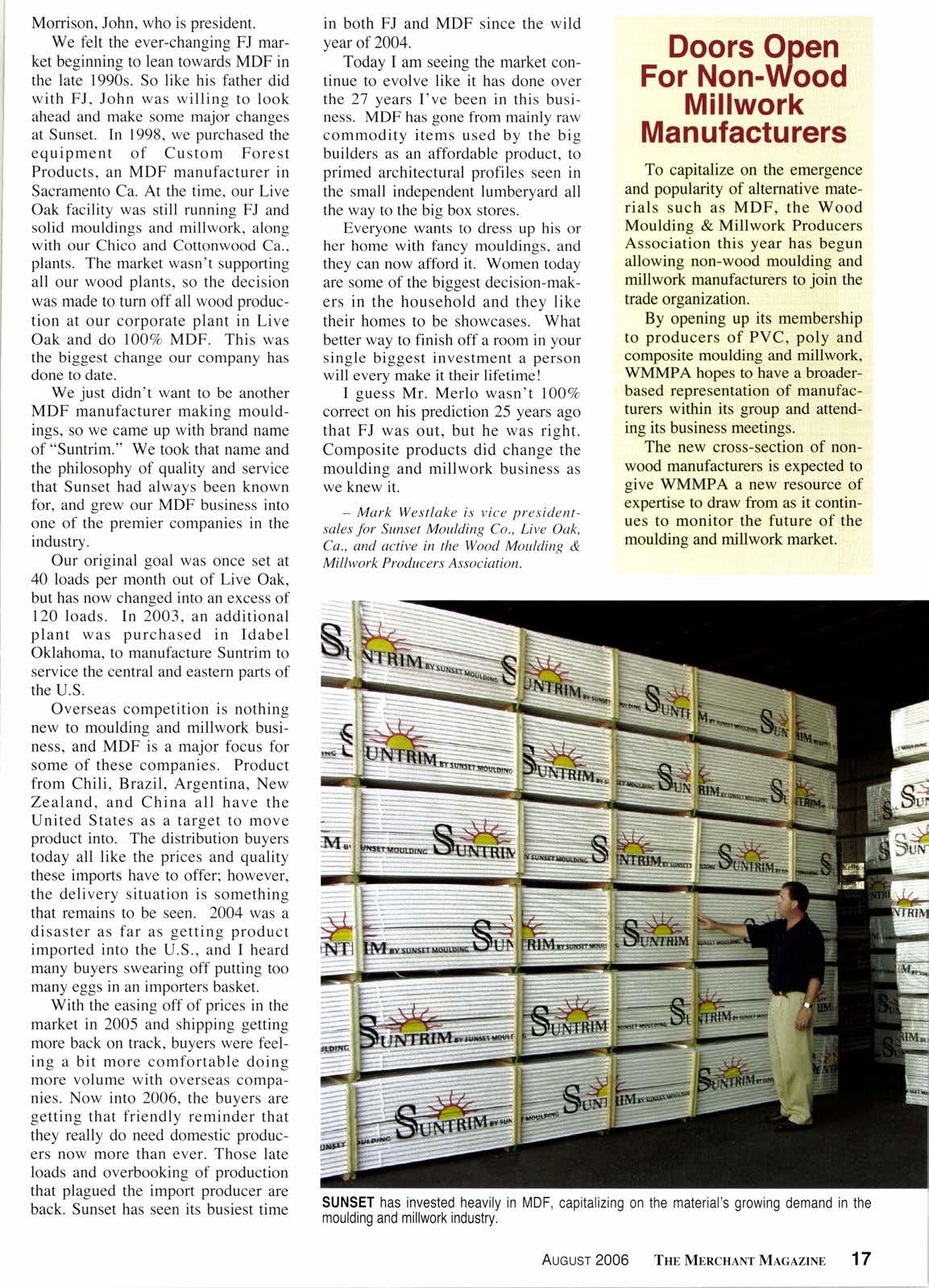
4 minute read
MDF powers growth in rnoulding business
By Mark Westlake Vice presidenrsales Sunset Mouldine Co.
ll fiDF was introduced into the IVlmillwork market in the mid to late 1970s. I believe one of the first major companies to give credibility to MDF was Louisiana Pacific Corp.
I remember one of my first National Sash & Door Jobbers Association meetings, as it was called before the name change to Association of Millwork Distributors, I attended was in Hawaii in the early 1980s. Harry Merlo, the president of L-P at the time, and the company I worked for, was the keynote speaker. He announced to the entire assembly that fingerjointed was on its way out and composite products were going to take over the business. This message sent a ripple throughout the meeting and the market, and was met with skepticism to say the least. I have to admit that at the time I was one of those who thought composite products would never replace wood in this business.
MDF has gone from mainly raw commodity items used by the big builders to primed architectural profiles seen in small independent lumberyards and big box stores.
When MDF was first produced, it was extremely heavy, 48- to 50-lb. board that was mainly run into patterns like flat jambs, hook strip, cleat, and some stools. It wasn't a big mover and mainly used by customers who wanted to save some money. Years later, things have changed dramatically with the improvements of the board weights, finishing equipment. primers and the customers' general acceptance of MDF into their marketplace.
This has opened the flood gates to an entirely different product for the moulding and millwork market. Traditional FJ moulding panerns that were larger and more ornate were not really affordable. Now, with the cost of MDF being what it is compared to FJ. the large architectural panerns are flourishing, not to mention the standard commodity casing and bases.
The company where I have hung my hat for the last 14 years, Sunset Moulding, Live Oak, Ca., has also felt these changes. Sunset Moulding was started in 1948 as a solid lineal plant by Gayle Morrison. Sunset went through a variety ofchanges, adding a revolutionary new product at the time, fingerjointed moulding and millwork, something in its day, to help compliment its solid program and then adding additional plants in Northern California. Sunset Moulding is now being directed by a second generation
Morrison, John, who is president.
We felt the ever-changing FJ market beginning to lean towards MDF in the late 1990s. So like his father did with FJ, John was willing to look ahead and make some major changes at Sunset. In 1998, we purchased the equipment of Custom Forest Products. an MDF manufacturer in Sacramento Ca. At the time. our Live Oak facility was still running FJ and solid mouldings and millwork, along with our Chico and Cottonwood Ca.. plants. The market wasn't supporting all our wood plants, so the decision was made to turn off all wood production at our corporate plant in Live Oak and do 100% MDF. This was the biggest change our company has done to date.

We just didn't want to be another MDF manufacturer making mouldings, so we came up with brand name of "Suntrim." We took that name and the philosophy of quality and service that Sunset had always been known for, and grew our MDF business into one of the premier companies in the industry.
Our original goal was once set at 40 loads per month out of Live Oak, but has now changed into an excess of 120 loads. In 2003. an additional plant was purchased in ldabel Oklahoma, to manufacture Suntrim to service the central and eastern parts of the U.S.
Overseas competition is nothing new to moulding and millwork business, and MDF is a major focus for some of these companies. Product from Chili, Brazil, Argentina, New Zealand, and China all have the United States as a target to move product into. The distribution buyers today all like the prices and quality these imports have to offer; however, the delivery situation is something that remains to be seen. 2004 was a disaster as far as getting product imported into the U.S., and I heard many buyers swearing off putting too many eggs in an importers basket.
With the easing off of prices in the market in 2005 and shipping getting more back on track, buyers were feeling a bit more comfortable doing more volume with overseas companies. Now into 2006, the buyers are getting that friendly reminder that they really do need domestic producers now more than ever. Those late loads and overbooking of production that plagued the import producer are back. Sunset has seen its busiest time in both FJ and MDF since the rvild year of 2004.
Today I am seeing the market continue to evolve like it has done over the 21 years I've been in this business. MDF has gone from mainly raw commodity items used by the big builders as an affordable product, to primed architectural profiles seen in the small independent lumberyard all the way to the big box stores.
Everyone wants to dress up his or her home with fancy mouldings, and they can now afford it. Women today are some of the biggest decision-makers in the household and they like their homes to be showcases. What better way to linish off a room in your single biggest investment a person will every make it their lifetime!
I guess Mr. Merlo wasn't 1007o correct on his prediction 25 years ago that FJ was out, but he was right. Composite products did change the moulding and millwork business as we knew it.
Mark Westlake is vice presidentsales .fnr Sunset Moulding Co., Live Oak, Ca., und active in the Wood Mouldine & M










